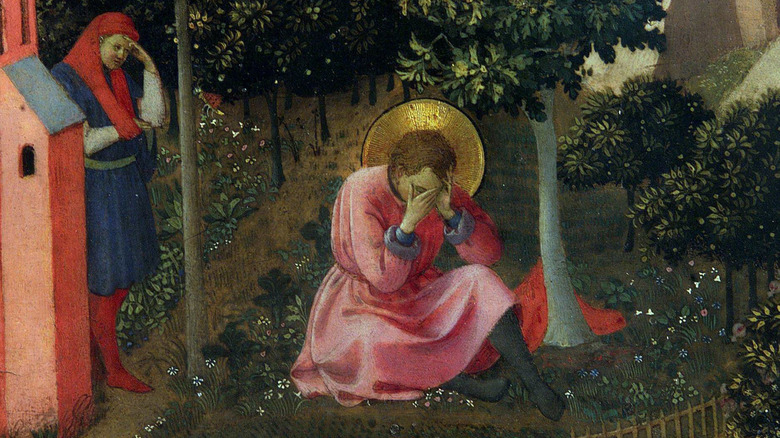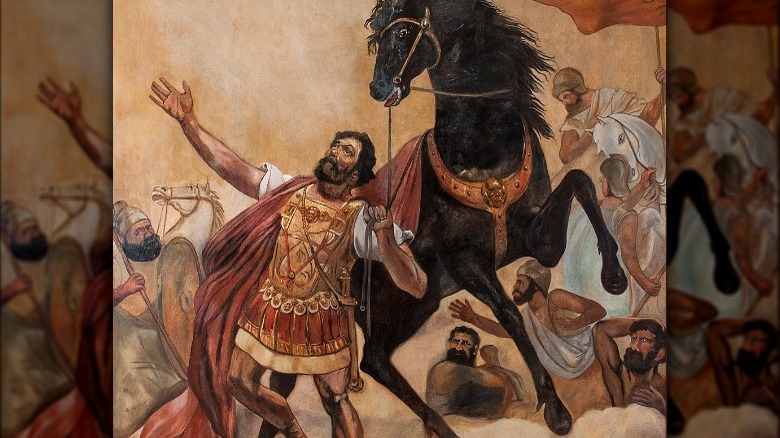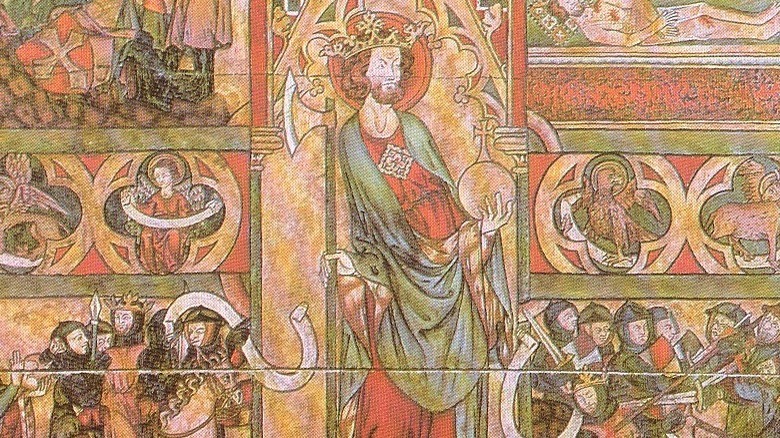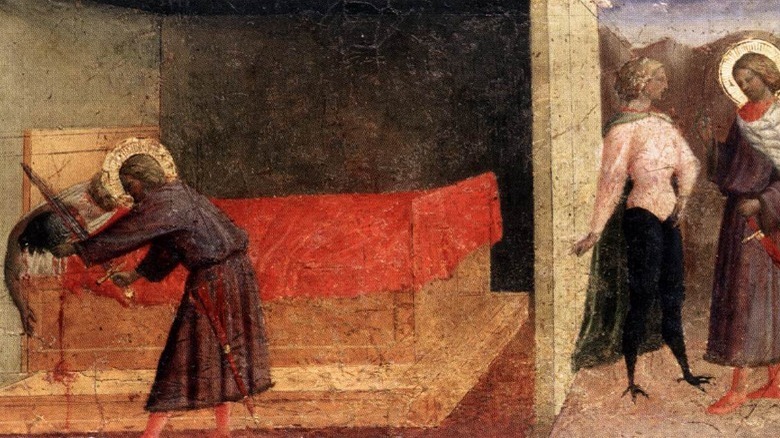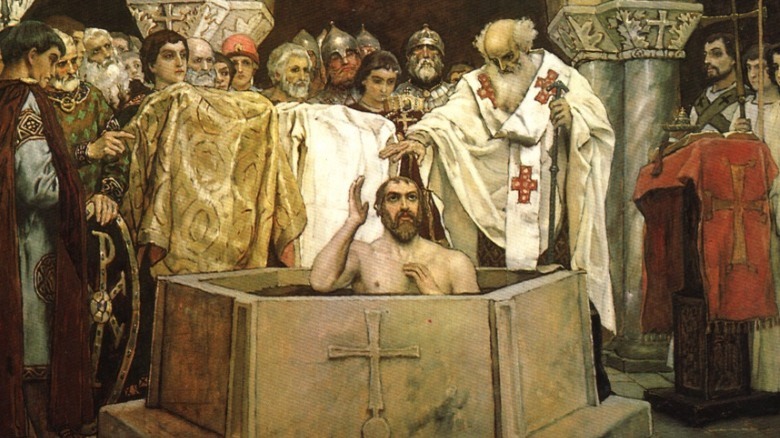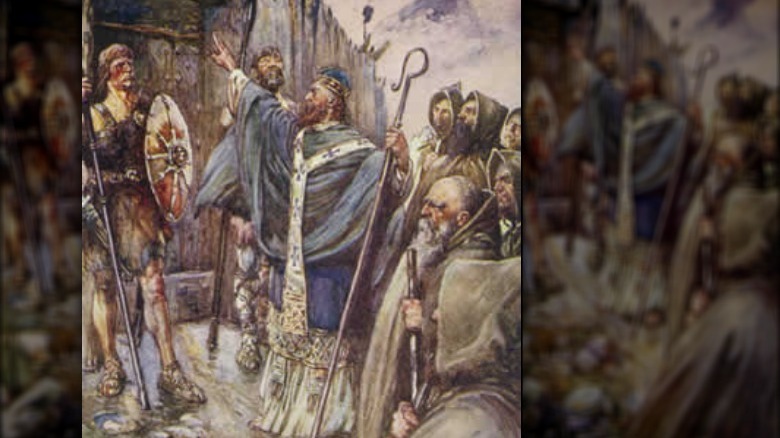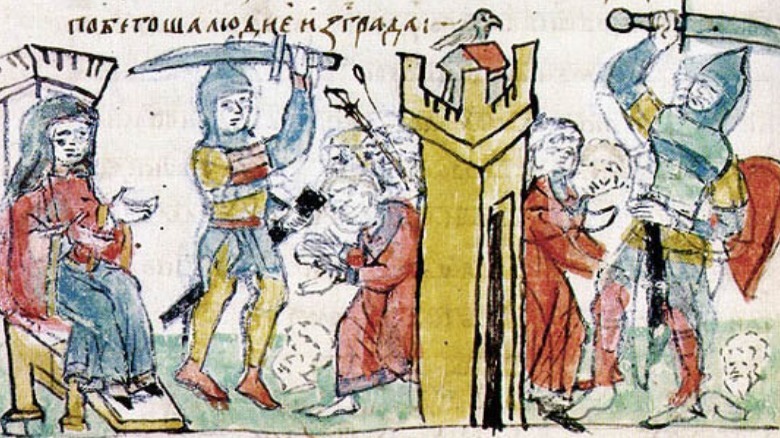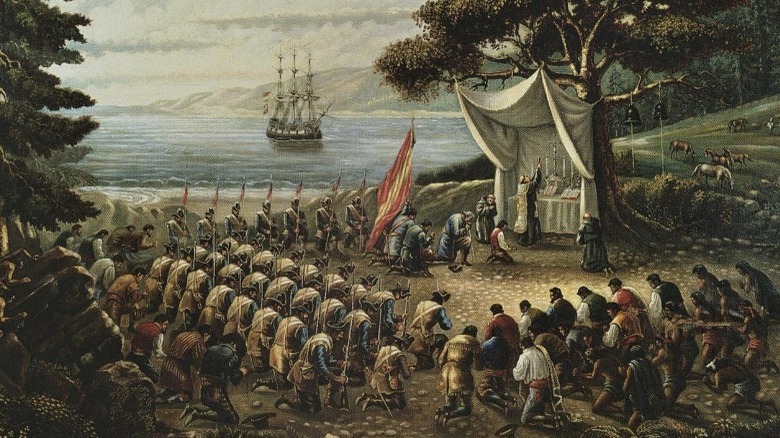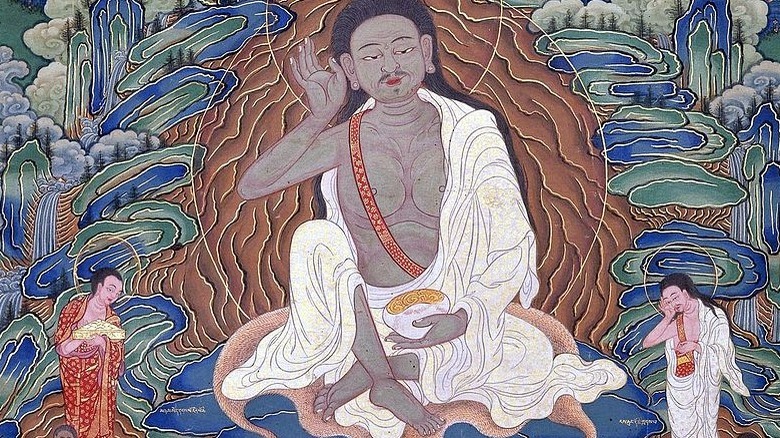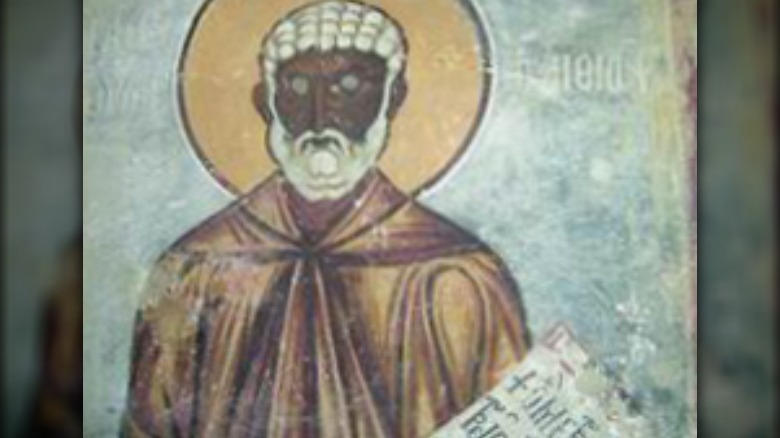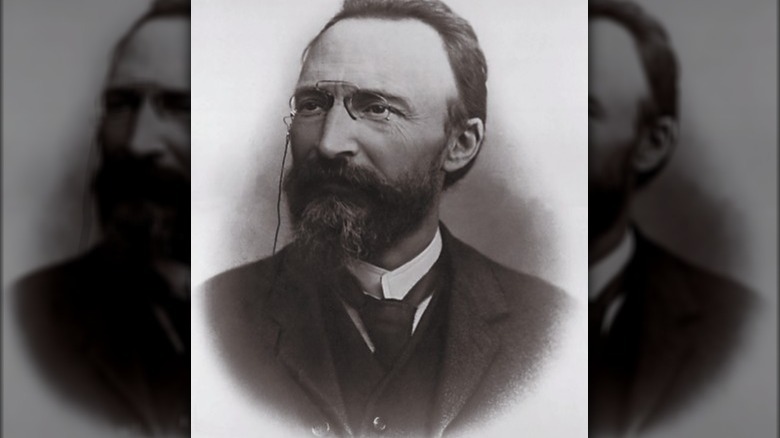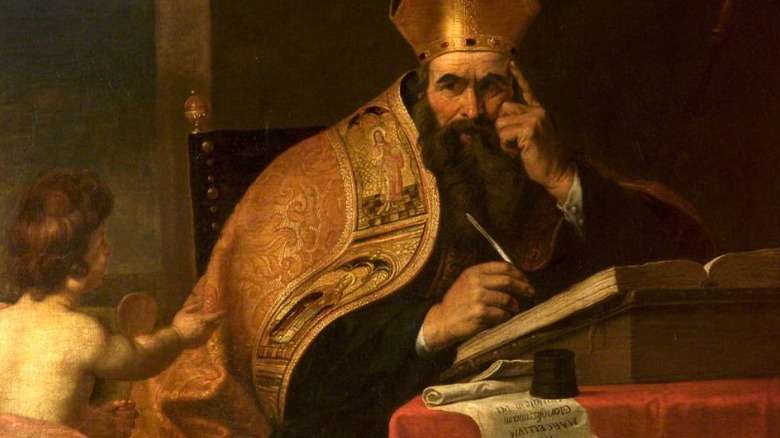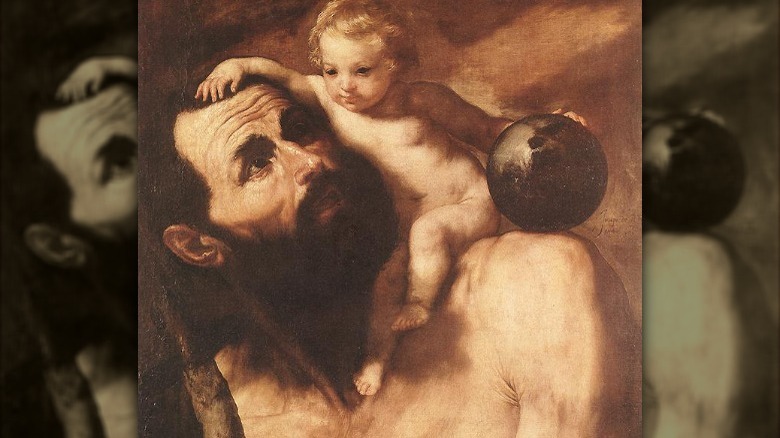The Worst Things Saints Have Ever Done
Saints are, in theory, the best of the best. The road from being just a normal, everyday, and eventually forgotten person to having a personalized feast day is a long one, and while this wasn't always the case, it's now the Roman Catholic papacy that has the sole right to bestow sainthood on new candidates. (Early on in the church's history, even bishops could make new saints.)
Saints need to check a lot of boxes before they're even considered. According to Mathew Schmalz, an associate professor of religion at the College of the Holy Cross (via The Conversation), sainthood is reserved for those who demonstrate some of the so-called "cardinal virtues" of justice, temperance, fortitude, and prudence. But they can't just be good people, they also have to be shown to abide by what are called "theological virtues," and those are charity, hope, and faith. In short? It doesn't matter how good a person you are, if you're not a believer, you can't be a saint.
But here's the thing — there are some saints that may have fulfilled those requirements later in life, but only turned to all that holiness after some serious sinning. It turns out that someone can dabble in murder, kidnapping, genocide, and even kill their own family, yet still become a saint.
St. Paul led the crusade to persecute — and execute — lots of people
Biographies of St. Paul — like the one from Christianity Today — tend to be light on the early years, and jump right into his missionary work, his teaching, and his letter-writing. What are they skipping over?
A lot. Between 30 and 33, Paul — who is also known as Saul of Tarsus — was busy leading the crusade against early Christians. He was getting his hands dirty doing it, too. In Acts 8:1-3 (via The Bible Journey), he's described as going from house to house through the city of Jerusalem, looking for members of the local Christian church so he could have them escorted right to prison. What happened next was nothing short of awful. Anyone Saul found to be a blasphemer was stoned to death, and that included Christianity's first martyr, St. Stephen. Stephen, says Learn Religions, had been gifted with the ability to perform miracles. It didn't save his life, though.
After Stephen's execution, Saul took his show on the road. He headed to Damascus, where he was determined to bring the same fire-and-brimstone sort of murder to a whole new population of Christ's followers. Fortunately for them, Christ appeared to Saul on the outskirts of the city, and he was converted.
St. Olaf converted the Vikings by force
"Olaf" is a pretty standard sort of name for a Viking, so let's get specific and talk about Olaf II Haraldsson. He lived from 995 to 1030, and in addition to being a saint, he was also the king of Norway, the one who's credited with the nation's conversion to Christianity, says Britannica. He was also a widely hated, wildly bloodthirsty Viking.
According to the Christian History Institute, Olaf made his raiding-and-pillaging debut when he was just 12 years old, and that was just the start of raids. Favorite targets included Holland and England, where he made it quite clear what he thought of religion. He and his men hit Canterbury in 1011, where he took it upon himself to kill the archbishop. His weapon of choice? Human bones.
He was about to set his sights on Jerusalem when he had a vision, headed to Norway, announced that he was now king, and was going to help pagans find the path to salvation via Christianity. While he did good things like building churches, he also executed those he found still holding harvest feasts and celebrating Yule. His heavy-handed, forced conversions made him incredibly unpopular, and after losing control of the country, he died in 1030, during an attempt to reclaim his throne. Christianity had enough of a foothold that the V&A Museum says he was declared a saint just a year after he was killed — or, as the story goes, martyred by non-believers.
St. Julian the Hospitaller killed his parents
Some of the church's older saints are stuck in that weird place between history and legend, and Aleteia says that's the case with St. Julian the Hospitaller. He's widely known as the patron saint of travelers, and there's a popular story about him finding a leper who had collapsed in the snow one night. After picking the man up and carrying him to his own bed, he heard God telling him that he was forgiven.
What was he forgiven for? Killing his parents. According to the story (told by the University of Rochester), it's the Oedipus-like tale of a boy who is told that he's cursed to kill his parents. Thinking he's going to prevent that by leaving his homeland, he does — then, he goes on with his life, and grows up to become a successful family man.
Meanwhile, his parents never stopped looking for him, and finally found his home. Julian was away, but they were welcomed by his wife and soon fell into a deep sleep in their hosts' bed. When Julian returned, he immediately came to the conclusion that the two figures in the bed were his wife and her lover. It was only after he killed them that he not only fulfilled the prophecy but turned around to see his horrified — but still devoted — wife.
St. Vladimir killed his brothers for the throne
When Kyiv's Grand Prince Sviatoslav Igorevich died in 977, he left behind three sons: Oleg, Yaropolk, and Vladimir. While the older two fought for the crown, Vladimir headed off to Norway, raised an army, then returned to carve a bloody path through what was now Yaropolk's kingdom. When he reached his brother's stronghold, he first killed him, then forced Yaropolk's lover to become one of his wives ... after he raped her. And it's worth noting that she was just one of many, many wives and concubines: According to Ozy, he had over 800 of them combined.
So how the heck did he become a saint? And it's worth mentioning that he's not just any saint: He's the Holy Great Prince Vladimir, equal of the apostles, and patron saint of Ukraine and Russia.
Vladimir was determined to unite his kingdom, and decided religion was the way to cement his rule. His earliest attempts involved taking the pagan deities of various tribes and turning them into a sort of national pagan religion, with a thunder god named Perun at the top. When that didn't work, he decided to give the same thing a try with another new, upstart religion: Christianity. After being baptized in 988, he kicked off a campaign of "conversion ... or else," and built churches even as he destroyed traces of pagan worship. All that earlier stuff just became proof of God's forgiveness, and Vladimir became a saint.
St. Colmcille started a war and prayed for the death of thousands
That whole "forgive and forget" thing? That wasn't exactly in St. Colmcille's book. St. Colmcille is one of Ireland's three patron saints (along with Patrick and Brigid), and his story is a little more bloodshed-y than his fellow saints, says the BBC.
Colmcille lived in the 6th century, and he was one of many descendants of the warlord Niall of the Nine Hostages. He did, indeed, start out as a monk, and it was in 560 that he copied a book of Psalms without getting permission from his teacher. Things went sideways, and the dispute went all the way to the king. When said king sided with Colmcille's teacher, what's a monk to do? Just accept it? Not if you're Colmcille: Donegal Diaspora says he started a war.
He went to Clan Neill and suggested the king needed to be taken down a peg or two. It ended up kicking off the Battle of Cul Dreimhne, and thousands of men were slaughtered on the battlefield. (But, legend says, only one person on the side of Colmcille.) He felt so guilty about the slaughter that he went into a self-imposed exile, promising to convert as many people as he'd killed.
St. Olga went on a John Wick-style killing spree
Ukraine has a long history of not putting up with anyone's [expletive]. Miles Pattenden, a senior research fellow for the Australian Catholic University, says (via The Conversation) that the future saint, Olga, made it quite clear that she was not to be trifled with just days after the death of her husband, Prince Igor. Igor was executed around 945 by some local rivals in a particularly gruesome way, then his killers courted the newly widowed Olga with a proposal to marry their leader. She bid them return to their boats, but when they did, they found them at bottom of a pit, where they were then buried alive.
That was just the start: After massacring around 5,000 people who had shown up for her husband's funeral feast, Olga struck a deal with the city of Iskorosten (now Korosten). She agreed to peace, for a tribute: three pigeons and three sparrows, collected from each home in the city and gifted to her. The tribute was gathered, and Olga accepted it — then she tied lit sulfur cloths to each bird and released them. The birds flew home to roost, and set fire to buildings as they did. The people who fled were captured and enslaved.
After Olga got her vengeance, she went on to rule in peace for years. The Collector says she was baptized by Emperor Constantine, became a champion of her new religion, and died in 969.
Junipero Serra spearheaded forced conversion of Native Americans
The popular story about Father Junipero Serra says (via The Guardian) that he was a kindly Franciscan monk who headed to California in 1769, with the goal of protecting and aiding the native people who were being subjected to horrible abuses from the Spanish military and colonialists.
Serra spearheaded a movement to bring tens of thousands of people into Catholic missions, and while one very generous account of them said they were places where people could get a hearty meal and worship Christ, others were less generous. It was historian Carey McWilliams who wrote that they were more like "a series of picturesque charnel houses." Native Americans were used by the missions as a source of slave labor. Families were separated, people were restricted to living quarters where disease was rampant, and were beaten for trying to leave.
Vox says that the controversy over the 2015 canonization of Junipero Serra brought to light some terrible statistics, like the fact that birth and death records revealed more people died on his watch than were born during it. Even those who say Serra stepped into a situation where there was no possible way to make life bearable for those living under the bootheel of the Spanish have to face another accusation: Serra — and other missionaries — were also committing "cultural genocide," destroying their entire way of life. It's definitely not a good look.
Milarepa turned to the dark arts
Milarepa, says Learn Religions, is one of Tibet's most beloved saints, and his story has been told to nearly 1,000 years of Buddhists.
Born around 1052 to a wealthy family, Milarepa lost his father when he was still young. He left instructions for his brother and sister to oversee his fortune, held in trust until Milarepa came of age. Instead of respecting those wishes, the brother and sister kept the fortune and cast Milarepa, his mother, and sister out on the street.
His mother demanded that he see justice done, so Milarepa turned to the dark arts. After apprenticing to a sorcerer, his aunt's and uncle's entire families had been killed by a house that collapsed on them. Still not content, he summoned a storm to destroy their crops as well — but when he realized that famine meant the people of his village were suffering, too, he turned himself over to the teachings of Marpa Lotsawa. After years of hard labor and devotion only to Mahamudra, he gained enlightenment before dying sometime around 1135.
Moses the Ethiopian ran with a group of killers
Aleteia says that it was Palladius of Galatia who wrote the most complete history of the 4th-century monk known as St. Moses the Black (or, as the Orthodox Church in America calls him, Moses the Ethiopian of Scete).
Moses started out as a slave in the home of a government official, and Palladius wrote that "His own master drove him out because of his immorality and brigandage. For he was said to go even the length of murder." Once he was out on the street, Moses didn't change his ways right away. Instead, he fell in with a gang known for terrorizing the entire area with the constant threat of murder, robbery, and countless other violent crimes. When one of his deadly schemes was interrupted by a shepherd, he plotted his revenge, searched for the man, and instead, found himself in a local monastery.
Enamored with the life of the monks he met there, he repented and insisted that he be allowed to join them. They eventually agreed, and when his murderous band later tracked him down, he converted them all and convinced them, too, to become monks. They lived at the monastery for years, until the now 75-year-old Moses sent his disciples away ahead of an imminent attack by a group of murderous thieves, much like the one he had once led. He was killed in the attack, and is now one of the patron saints of nonviolence.
Bartolo Longo spent his early days as a priest ... of Satan
Bartolo Longo isn't technically a saint ... yet, at least, as Ozy says that he's just one step away from full sainthood. In addition to earning the title of "Blessed," other descriptors were tossed around: He was given a feast day of Oct.5 (via the University of Dayton) and called an "apostle of the rosary," which is a long way from the time he spent as a satanic priest.
Longo was born in 1841, and although he was raised in a Catholic family, his faith faltered after the death of his mother. Add in the distinctly anti-Catholic environment he found himself in while at the University of Naples, and he would later write he had been "ensnared on the enticing hook of freedom of conscience and thought, seduced by the novelties of science." He jumped feet-first into the world of spiritualism, the occult, and finally, into everything from orgies to satanic rituals. He went so deep into the occult that he believed himself possessed by a demon that he had promised his soul to, and reportedly sank deep into depression and anxiety.
His devotion to the devil ended when he reportedly heard his father tell him to "Return to God!" so he did. With guidance from a Dominican priest, he became a lay brother named Brother Rosario, married Countess Mariana di Fusco, and restored Pompeii's Our Lady of the Rosary Shrine.
St. Augustine was a notorious playboy and thief
St. Augustine might be a respected church father, and the idea of reading his "Confessions" might seem so boring it'd be preferable to go get a few teeth pulled, but his confessions are, well, something on a whole other level. The New Yorker says that it was this respected, revered saint who "invented sex," and while that might be a bit of an exaggeration, it's not by much.
Augustine wrote about some pretty lurid affairs, and while things like having a child out of wedlock might not be too surprising to our 21st-century sensibilities, there's no denying that he treated the women he professed to love pretty badly. Aleteia says that after almost two decades of sampling all the fleshy pleasures the world had to offer, he settled down with a woman who bore his son. He records his son's name — Adeodatus — but never hers. They never married, and when he refused on multiple occasions, she left.
It was enough to make Augustine wonder if there was something to this marriage thing after all, but before he could marry the younger women who had been promised to him, he ended up hooking up with still more women. (He was in his 30s, and he needed to wait until she was old enough to legally marry. So, there's another yikes.) It was so bad that even his mother intervened and asked him to please, please, please stop seducing married women.
St. Christopher traveled with the devil
St. Christopher is the patron saint of travelers, an association he got for carrying a child — who was Christ in disguise — safely across a river. Admittedly, Christopher has what the Los Angeles Times calls a "wobbly historical status," and although it's not certain whether or not he was based on a real person, he's still part of the Catholic roster of go-to saints. That said, the story — historical or invented by medieval monks — gives him a rather questionable history.
Christopher, says Arabic studies historian Daniel Peterson (via Deseret News), didn't always go by Christopher. His given name was Reprobus, which essentially meant "rejected." He was said to be a giant, who thought only the most powerful person in the world was worthy of his strength and service. That was originally a Canaanite king, but when Reprobus learned that he was afraid of the devil, he decided that he was going to go serve this devil fellow, instead — and he did. It wasn't until he met a bandit who wouldn't go near or defile a crucifix that he decided this Jesus guy must be even more powerful, so he jumped ship and changed his loyalties again.
It was while he was doing the bidding of a hermit and ferrying people across the river that he met Christ and was given his name — which means Christ-bearer.
